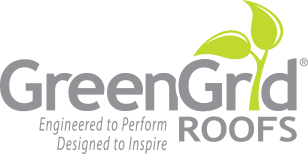GreenGrid
Basic Vegetative Green Roof Definitions:
Vegetative green roofs can be categorized as extensive, semi-intensive, or intensive, depending on the depth of growing medium, design, and the amount of maintenance they need:
Extensive vegetative green roofs, which are 6 inches or shallower and are frequently designed to satisfy specific engineering and performance goals. Extensive design typically gives the owner the highest benefit-to-cost ratio. In most climates, a properly designed Extensive vegetative green roof cover will provide a durable, low-maintenance system that can realize the many benefits that vegetative roofs have to offer. Extensive vegetative green roofs are designed to be virtually self-sustaining and should require only a minimum of maintenance: occasional weeding and a yearly application of slow-release fertilizer to boost growth. Extensive roofs are usually only accessed for maintenance.
Semi-Intensive vegetative green roofs, which we refer to as designed vegetative green roofs, have a level of design with regard to planting layout. Depth of growing medium is typically 6 to 20 inches and can be planted with a large variety of plants. These vegetative green roofs are considered semi-intensive due to the landscape design coupled with increased levels of maintenance: dedicated irrigation system (variable), annual fertilization, and advanced horticultural care. Semi-intensive roofs are often used as building amenities accessible to the occupants as an area to enjoy nature.
Intensive vegetative green roofs, which are often referred to as rooftop gardens, require a reasonable depth of growing medium to grow larger plants or even conventional lawns. Rooftop gardens are considered intensive because they are labor-intensive to construct and maintain: a dedicated irrigation system, continual fertilization, and overall advanced horticultural care are required. Intensive roofs are park-like amenities accessible to building occupants or the general public.
